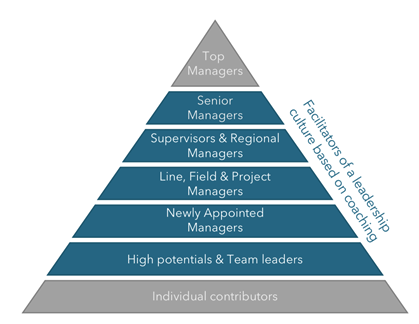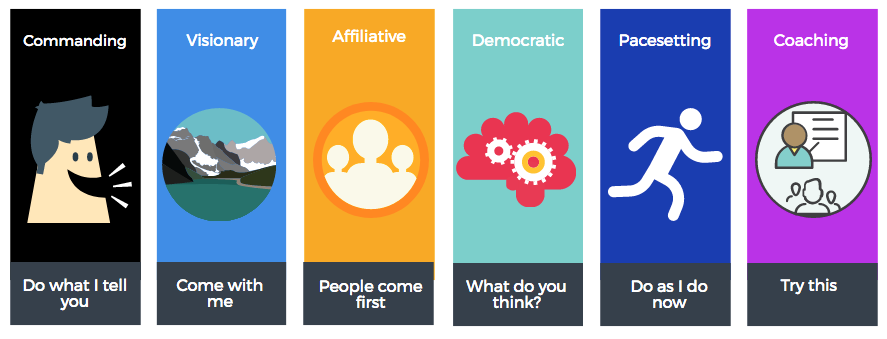When given the opportunity to learn and grow, people thrive. By adopting a coaching mentality and approach, managers can help members of their team realize their potential.
Why should managers devote time and effort to coaching their team?
Research shows that coaching leads to better engagement, higher productivity and enhanced customer service. It also helps an employee improve performance, overcome challenges, reach goals and build self-confidence.
The importance of coaching over just managing
To become a true Leader, a manager must develop the ability to coach others.
It is core skill required of every successful manager in the 21st century.
We all know that the days of command and control leadership as a standard way of managing people are long gone.
However, the art of coaching -today’s most effective way for managers to lead- requires learning a set of skills. If managers do not become skilled at coaching their employees, it is unlikely that they will be able to achieve sustainable long-term positive results for themselves or their organizations.
There are many different definitions of coaching, but the following one is the most appropriate for this case:
“Coaching is about connecting with people, inspiring them to do their best and helping them to grow. It’s also about challenging people to come up with the answers they require on their own.” Ed Batista
Several in-field studies report how a poor coaching-oriented management style has bad consequences on the motivation and productivity of employees.
Developing the skills and changing a managerial approach amid daily demands can be difficult.
On the other hand, it is widely demonstrated that organizations become more productive and employees become more engaged when adopting these two organizational habits:
- Managers using listening skills and communication to involve others, setting clear performance expectations, self-awareness (Sparks and Gentry 2008)
- Subordinates having regular conversations with Leaders or coaches where individual and organizational goals are discussed, Leaders give constructive feedback, both positive and negative, and Leaders reflect on their own leadership practices (Larsson and Vinberg 2010)
As a way of managing people, coaching demands for a set of new approaches such as:
- Collaborating instead of controlling
- Delegating more responsibility
- Talking less, listening more
- Giving fewer orders, asking more questions
- Giving specific feedback instead of making judgements
Shifting towards a coaching approach clearly requires the development of strong conversational skills and here again, research supports the idea that the majority of managers widely underperform in the ability to develop their teams through authentic, empowering and effective conversations, which are at the core of coaching.
What types of manager can benefit most from coaching skills?
All managers, regardless of level, should be trained in how to inspire and empowering employees rather than just telling them what to do; this provides opportunities for growth, development and autonomy.
Some levels, however, are particularly indicated when it comes to be identified as potential facilitators of a leadership culture based on coaching:

These groups are most exposed to the opportunity -very often accompanied by the fear- of coaching their employees to the highest possible performance achievement hand engagement.
At the same time, they represent an incredible opportunity for the organization as a whole to change gear and start performing at a new level: They are the best gateway to inject a new leadership culture through example, nudge and listening.
What are the benefits of practicing on conversations for Leaders aspiring to become coaches?
Practice is the most effective way to improve conversational skills and to shift the approach of managers toward coaching.
The more you practice, the more you gain confidence and raise your self-awareness.
Your comfort zone starts to expand as soon as you move the first step toward consistent practice. Practicing by interacting in critical conversations is the best way to improve managers’ ability to coach their employees.
The typical shift in observable behaviors we normally see in Leaders undergoing a consistent practice program on conversations can be summarized as follows:
| Manager Approach | Coach Approach |
| Answer questions when asked | Asks questions to help employees better understand options and strategies |
| Describes excellence to team | Models excellence by working with team members and mentoring achievement |
| Evaluates results and provides feedback | Observes behaviors and provides feedback |
| Provides coaching when necessary | Provides coaching as an ongoing priority |
| Coaches extemporaneously | Follows structured coaching strategy |
| Gives team members action steps to follow and then resumes other duties | Guides team members through steps as they implement action plan |
| Provides feedback during evaluation and occasionally between evaluations | Provides timely, consistent feedback during the daily flow of work |
| Treats obstacles with team members as the real issues | Probes issues with team members to discover the root cause behind the obstacles |
| Outlines challenges for team members | Guides and supports team members as they uncover their own challenges |
Which Skills get involved the most in this amazing shift?
There are many skills involved with this change of approach.
Just to mention the most prominent ones, I would say that the following twenty are for sure at the center of this revolution:
- Be aware of other people’s needs
- Aim for continuous improvement
- Be confident with the organization context
- Be diplomatic and tactful
- Be inspiring
- Communicate efficiently
- Ease change
- Encourage and value input
- Ensure accountability
- Find solutions
- Generate a positive mood
- Give credit and rewards
- Give immediate feedback when needed
- Have a clear vision of the problem
- Inspire standard of performance
- Manage objections
- Remove obstacles
- Set goals and long-term perspectives
- Share decisions made
- Tailor approach and speech
But those of you who follow my series here on the blog certainly know, by now, that the two most important indicators that get affected by practice are:
- Confidence. The degree of courage, determination, fearlessness and self-perceived experience with which Leaders approach these types of conversation using a coach-oriented approach.
- Self-Awareness. The degree of consciousness, precision and sharpness with which Leaders are capable of assessing their own performance at the end of the task.
What types of conversation can impact most this shift?
Leaders face every day a great number of occasions to enter conversations with their employees, and there are so many types of conversations to practice with that any list would fall short.
However, should I be asked to define a very short list of those conversations that can really make a huge difference in inspiring, developing and leading towards a better team performance, I would certainly indicate the following four:
- Negotiating an objective. Leverage a coaching style to motivate the employees and to increase their self-confidence and self-esteem. They will perform better as well as strive for bigger challenges.
- Delegating. One of the crucial tasks of any Leader. Adding a coaching approach will improve the employee’s performance, since they will feel rewarded and appreciated, encouraging them to stay motivated and keep up the good work.
- Priority Setting Nudge. At some point, every employee needs a gentle push; a nudge to improve their performance. Coaching them through their daily organizational challenges will grow their ability to work better and more aligned with the company’s objectives.
- Giving performance feedback. Feedback is a key moment of the relationship with employees. Being able to coach them through a better understanding of their current limits is essential to turn obstacles into opportunities.
How can you deliver meaningful practice to your Leaders?
Fostering the ability to leverage fruitful and empowering conversation throughout the entire organization is the new goal of any talent development professional, since more and more multi-directional and cross-function leadership conversations are needed.
This is even more important in view of the general tendency I outlined above: supporting Leaders to adopt a coaching style requires a great deal of innovation in training design, to make sure that practice on conversation is not only included but, even better, placed at the center of the journey.
Training on conversation means becoming an interactive part in a dialogue and receiving continuous and multi-source feedback not only on communication skills, but also on self-awareness and self-control.
Role Playing is one of the most important learning strategies for Conversational Leadership development.
However, as discussed in another article (“Digital Role Plays, the Best Way to Develop Conversational Leadership“) it does not come without some limitations if approached the traditional way.
Digital Role Play, instead, can be an interesting solution to overcome those limitations that are typical of the in-class approach.
In this article (“Digital Role Play Stripped Bare“) I explain what is a Digital Role Play and how it can be helpful to support a leadership training program aiming at delivering sound practice on conversations.
What is the typical effort in practicing to improve on coaching skills?
Having delivered thousands of practice bootcamps on conversations to support the transition of managers to a coaching approach, here are some of the evidences we collected on the field.
An average individual training schedule typically engages the trainee for 1-1.5 hour / month, with one or two simulations every other week.
On average, it takes between 5 and 6 months of regular training for 68% of trainees to gain an improvement of around 25% on their initial confidence level in the most popular types of conversations.
At the same time, we noticed that within 9 months of regular training, 92% of trainees achieve the same result.
We call it the efficient threshold of confidence, it’s where trainees get the greatest benefit in terms of performance at the most possible sustainable impact in terms of participation.
Where to go from here
You may now be interested in learning more about tips to select your next Digital Role Play system.
At the bottom of the article mentioned above (“Digital Role Plays, the Best Way to Develop Conversational Leadership“) I provide you with a detailed checklist about what to look at when deciding on which platform to adopt.
It is also very important to reflect on how to integrate Digital Role Play into your existing strategy, since too often these types of tools are just placed at the end of a classic course for a quick “follow-up” that, most of the time, does not add any value, which results in underutilization of the enormous power and potential of these kinds of solutions.
Read this article (“Flipping the Leadership Development Strategy with Actionable and Scalable Programs“) to learn more about the best way to truly integrate Digital Role Plays into your L&D strategy.
Finally, if you are interested in discovering how we here at SkillGym deliver the best in class Digital Role Plays, feel free to book a 1-hour discovery call.


















